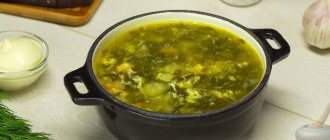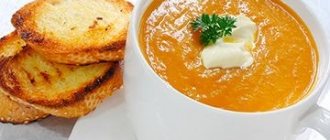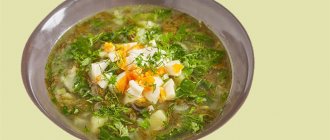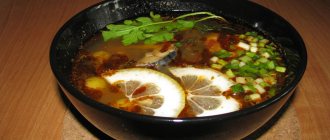1 Finely chop the carrots, turnips and white parts of the leek, place in a saucepan, add 2 tablespoons of oil and simmer for 10-15 minutes.
2 Then add 4 cups of water, potatoes and washed rice. Cover with a lid, place over low heat and simmer for 30-35 minutes.
3 Rub the vegetables together with the broth through a sieve, dilute with 2 cups of hot milk, add salt, add butter and stir.
4 When serving, add boiled green or canned peas to the soup.
The calorie content of vegetable puree soup is 121 kcal.
Compound
: Tomatoes in their own juice, Cannellini beans, Country bread, Olive oil, Sage leaves, Garlic, Salt, Ground black pepper
Compound
: Tomatoes, Chicken broth, Lemons, Red onion, Olive oil, Cilantro, Honey, Ginger, Paprika, Cinnamon, Cumin, Parsley, Salt, Ground black pepper
Compound
: Meat broth, Egg, Parmesan cheese, Semolina, Spices
Compound
: Cottage cheese, Apples, Sour cream, Milk, Egg, Sugar, Butter, Raisins, Semolina, Vanillin
Compound
: Wheat flour, Milk, Sugar, Vegetable oil, Egg, Cocoa, Baking powder, Salt
Soups are a unique dish, without false modesty. Very nourishing, hot, nutritious, they contain many useful substances and vitamins, and each soup has certain beneficial properties: borscht is good for anemia, pea soup improves digestion and promotes hair and nail growth, mushroom soup saturates the body with magnesium, vegetable soup burns fats and serves as a valuable source of vitamins and fiber; rice or oatmeal soup is useful for cleansing the body; chicken soup will be appreciated by athletes, pregnant women, and teenagers.
A plate of soup eaten at lunch satisfies hunger for 3-4 hours, while the calorie content of soups is quite low
. Of course, fatty, thick, rich soups with meat, potatoes, grains, pasta, and fried foods contain a lot of calories, but most soups are still low-calorie dishes. For example, a cup of Ukrainian borscht seasoned with sour cream will contain no more than 200 kcal.
In addition to being low in calories, soups have many other valuable properties: they contain many nutrients, incl. amino acids necessary for our body, they contain many vitamins and mineral compounds, they improve digestion and speed up metabolism.
It is certainly possible to lose weight with soups, but there are additional requirements for weight loss soups. The calorie content of soups for weight loss should be minimal, so they are boiled in vegetable or low-fat (second) chicken broth without potatoes. Vegetables are not fried before adding to the soup, salt is used minimally, but spices that promote fat burning are used liberally - chili pepper, ginger, curry, turmeric, garlic, etc. To lose weight with soup, you need to eat it at least once a day, and soup diets involve eating soup for weight loss 3-5 times a day. The only drinks allowed are pure water and unsweetened green tea. So you can lose 5-8 kg in a week with soup.
What are the benefits of soups?
Any soup is an excellent source of strength and energy. The soup contains a lot of fiber, carbohydrates and minerals (magnesium, iron, potassium, etc.), vitamins (E, beta-carotene, group B).
In addition, in boiled vegetables during the preparation of soups, most of the beneficial properties are retained, and they are absorbed and digested much better by the body. Yushka made from vegetable broth is also healthy and has great nutritional value, since vitamins and minerals from vegetables are washed out into the broth.
Regardless of the calorie content of soups, they are simply irreplaceable for the human body:
- Improve appetite and digestion;
- Restore the functioning of the gastrointestinal tract;
- Normalize blood pressure;
- Restore fluid balance in the body;
- Reduce cholesterol levels;
- Cleanse the body of toxins;
- Protects against cardiovascular diseases.
Therefore, many try not only to lose weight with soups, but also include them in therapeutic diets. Well, the ability of soups to restore strength after long-term illnesses and warm up the body during the cold season is no secret to anyone.
How many calories are in soups
As mentioned above, the calorie content of soups varies. Several factors influence how many calories a soup contains:
- caloric content (fat content) of the broth;
- calorie content of ingredients used for soup;
- the method of processing the ingredients (whether they are fried in oil or not before putting them in the pan, etc.);
- calorie content of soup dressing, if any (sour cream, mayonnaise).
We present to you approximate information about how many calories are in the soups we most consume.
The calorie content of borscht is approximately 35 kcal per 100 g (excluding the sour cream with which you season this soup). Beetroot contains 29 kcal per 100 g. The calorie content of pea soup is 66 kcal per 100 g, fresh green pea soup is 57 kcal per 100 g.
The calorie content of mushroom soup is approximately 26 kcal per 100 g, and that of cauliflower soup is 27 kcal per 100 g.
The calorie content of vegetable soup is 25-28 kcal per 100 g, and the calorie content of the same vegetable soup seasoned with sour cream is about 40 kcal per 100 g. The calorie content of noodle soup with 3.2% milk is 66 kcal. Bean soup contains 66 kcal per 100 g, tomato soup contains only 11 kcal per 100 g. The calorie content of cabbage soup is about 28-32 kcal per 100 g (excluding sour cream), the calorie content of pickle soup and fish soup is the same, about 46 kcal per 100 g. The calorie content of okroshka made with kvass is 52 kcal per 100 g, and that made with kefir is 47 kcal per 100 g.
The calorie content of chicken noodle soup is 62 kcal per 100 g. 100 g of rich mushroom soup contains 83 kcal. The calorie content of meat solyanka is 68 kcal per 100 g, the calorie content of mushroom puree soup with potatoes is 50 kcal per 100 g, the calorie content of lentil soup is 67 kcal per 100 g, the calorie content of bean soup with potatoes is 72 kcal per 100 g. The calorie content of soup with meatballs from meat is 57 kcal per 100 g, and the calorie content of soup with fish meatballs is 48 kcal per 100 g. The calorie content of mashed potato soup is 55 kcal per 100 g.
The calorie content of kharcho soup is 112 kcal per 100 g, 100 g of shurpa contains 78 kcal, and 100 g of khinkal soup contains 124 kcal. The calorie content of green pea puree soup is 82 kcal per 100 g.
Calorie table for soups and their nutritional value
The nutritional value of the main types of first courses is presented in the table:
| Soup name | Calorie content (kcal per 100 ml) |
| Chicken | 36 |
| Pea | 66 |
| Mushroom | 26 |
| Kharcho | 67 |
| With meatballs | 45,5 |
| Buckwheat | 33,6 |
| With vermicelli | 48 |
| Vegetable puree soup with chicken broth | 58,2 |
| Vegetable puree soup with meat broth | 21,1 |
| Sauerkraut cabbage soup | 32 |
| Cabbage soup with sour cream (depending on the fat content of sour cream) | 37,1-51,44 |
| Rassolnik | 42 |
| Solyanka (with beef and tomato) | 100 |
| Borsch | 49 |
| Minestrone (vegetable soup) | 39 |
| Beans with pepper | 63 |
| Onion with carrots | 44 |
| Potato | 38 |
Recipes for the most delicious soups
Eggplant puree soup is ideal for a diet. Take 600 g of fresh eggplant, 1 onion, a tablespoon of balsamic vinegar, 2 cloves of garlic, fresh thyme, salt, and olive oil to taste in 500 ml of water. Chop the eggplants, thyme, garlic, mix it all, add vinegar and fry in olive oil in a frying pan until tender. Separately, fry the crushed garlic and onion in oil in a saucepan, add the eggplants, cover with water and cook for 20 minutes, then grind in a blender. The calorie content of eggplant puree soup is 18 kcal per 100 g.
Hearty chicken noodle soup is not suitable for dietary nutrition, but it is quite suitable for recharging your strength and energy. For 3 legs, take 3 potatoes, half a glass of noodles, an onion, a carrot, a bunch of fresh herbs, pepper, and salt to taste. Put the legs to cook, after the water boils, put the unpeeled, cleanly washed onion into the pan. After 30 minutes, take it out, put the carrots cut into small cubes into the pan, and 5 minutes after that - the potatoes. Cook for another 15 minutes, add vermicelli and cook for another 15 minutes. Add the spices, turn off the soup and let it sit for 10 minutes before serving. The calorie content of soup with noodles and chicken is 132 kcal per 100 g.
Very tasty and healthy tomato soup with meatballs. For 2.5 liters of meat broth you will need 500 g of tomatoes, 400 g of onions, 300 g of minced meat, a glass of 40% cream, 100 g of vermicelli, 4 tablespoons of tomato paste, a tablespoon of red pepper, 2 bay leaves, salt , herbs, spices to taste. Add bay leaf to the broth and put on fire, add spices, pepper and onions cut into quarters. Cook for 20 minutes.
Take the minced meat, make small meatballs from it and put them in the pan. Add chopped tomatoes and tomato paste, stir, add vermicelli. When the water boils, turn on low heat and cook for 10 minutes, stirring. Then add salt and pepper. When the soup is ready, add cream and fresh parsley. Serve the soup with hot white toast or crispy fresh bread. The calorie content of soup with meatballs and tomatoes is 55 kcal per 100 g.
Anyone who loves mushroom soup will appreciate this recipe. Take 4 potatoes, 1 onion, 100 g vermicelli, 60 g dried porcini mushrooms, carrots, spices and salt to taste. Soak the mushrooms for 10-15 minutes, then drain the water. Place a pot of water on a hot stove. Chop the onion, grate the carrots on a coarse grater and fry them together in olive oil. When the water in the pan boils, add mushrooms and fried onions and carrots. Place peeled and chopped potatoes there. After 15-20 minutes, add vermicelli, herbs, spices, salt to the pan, turn off the heat and leave for 10-15 minutes. The soup is served with sour cream and herbs. Calorie content of soup with noodles and mushrooms is 110 kcal per 100 g.
If you liked this article, please vote for it:
(64 Votes)
Puree soups have a fairly high nutritional value, so they are superior in calorie content to traditional light soups. Thick, creamy dishes contain more proteins, fats and carbohydrates, although they are prepared from similar products.
Secrets on how to reduce the calorie content of soup
Body weight directly depends on the nutritional value of the soups consumed.
Nutritionists have calculated that a daily decrease in the energy value of a dish by just 100 kcal prevents the appearance of 1 kg of excess weight per year.
There are several simple rules, following which you can get rid of 500 grams of fat every week.
Cook with low-calorie foods
Many dishes will not lose their taste (or gain it) if their ingredients are changed.
For example, you can safely change components:
- whole milk – low-calorie;
- butter - olive oil or any vegetable oil;
- fatty meat (sausage, ham) - fish or lean veal;
- cereals - for vegetables and herbs;
- mayonnaise - for natural yogurt;
- sugar – for fructose, etc.
Important! It is advisable not to use starch, potatoes, rice, flour, sugar, seasonings with a high salt content, or canned foods when preparing dishes.
Do not fry vegetables
Fried food adds at least 150 kcal to each soup. An alternative is raw or steamed vegetables.
Use skinless meat
The main source of carbohydrates and fats is found not in the chicken flesh itself, but in its skin. When cooking meat, the skin must be removed.
Avoid fatty sauces
A good alternative to mayonnaise, full-fat sour cream and ketchup would be mustard, lemon or homemade pesto sauce with garlic and basil, natural yogurt, balsamic vinegar, etc.
Drain the first broth
When cooking broth, the first portion must be drained - it is full of antibiotics and chemicals that the animal consumed along with the food. The second broth is healthier and cleaner.
Do not use sour cream
Sour cream is a fairly fatty product. It is best to replace it with natural yogurt, mustard or homemade tomato paste.
Composition of puree soups
Almost any ingredients can be added to so-called cream soups, and this directly affects their composition and BJU. The first dish can be more calorie or dietary, so everyone chooses the appropriate cooking recipe.
The dish consists mainly of vegetables: cabbage, carrots, potatoes, mushrooms, tomatoes, onions and garlic. A little vegetable oil (preferably olive) is also added so that the puree soup does not turn out lean and tasteless.
The broth itself can be cooked with vegetables or meat. If you take chicken breast or beef, you will get a less nutritious dish, and pork broth will increase the calorie content of the puree soup to 150-200 kcal.
The composition may also include such non-standard ingredients as cod liver. It will increase the fat content of even the leanest vegetable soup more than butter or heavy cream, which is often used.
What are the benefits of soups?
Any soup is an excellent source of strength and energy. The soup contains a lot of fiber, carbohydrates and minerals (magnesium, iron, potassium, etc.), vitamins (E, beta-carotene, group B).
In addition, in boiled vegetables during the preparation of soups, most of the beneficial properties are retained, and they are absorbed and digested much better by the body. Yushka made from vegetable broth is also healthy and has great nutritional value, since vitamins and minerals from vegetables are washed out into the broth.
Regardless of the calorie content of soups, they are simply irreplaceable for the human body:
- Improve appetite and digestion;
- Restore the functioning of the gastrointestinal tract;
- Normalize blood pressure;
- Restore fluid balance in the body;
- Reduce cholesterol levels;
- Cleanse the body of toxins;
- Protects against cardiovascular diseases.
Therefore, many try not only to lose weight with soups, but also include them in therapeutic diets. Well, the ability of soups to restore strength after long-term illnesses and warm up the body during the cold season is no secret to anyone.
Cheese cream soup
Products (for 2 servings)
- Processed cheese – 90 g
- Potatoes – 220 g (2 pcs.)
- Onions – 70 g (1 pc.)
- Carrots – 50 g (1 pc.)
- Cream – 120 ml
- Butter – 30 g
- Vegetable oil – 30-40 g
- Water – 200 ml
- Salt - to taste
- Dill greens - to taste
- Hard cheese (Dutch) - to taste
Recipe
- Cut the onion into small cubes.
- Cut the carrots into half rings.
- Place a saucepan to heat up. Add vegetable oil and fry the chopped vegetables for 4-5 minutes.
- Meanwhile, cut the potatoes into slices.
- Add to fried vegetables. Pour in water so that it covers all the potatoes. Leave to cook for 20 minutes.
- After this, pour in the cream, add butter and simmer for another 10 minutes.
- Next, add the processed cheese, cut into cubes, into the soup. Add salt.
- Blend the soup with a blender until smooth.
- Cream cheese soup is ready! Serve cheese soup with chopped dill and grated hard Dutch cheese.
- Bon Appetit everyone!
Pumpkin cream soup
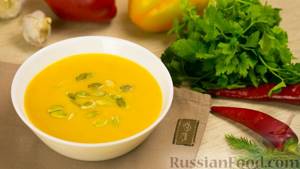
Products
- Pumpkin – 700 g
- Potatoes – 2-3 pcs.
- Carrots – 1-2 pcs.
- Onions – 1 pc.
- Garlic – 1-2 cloves
- Cream (20% fat) – 70 ml
- Olive oil – 3 tbsp. spoons
- Salt - to taste
- Pumpkin seeds (for serving) - to taste
- Water – 350 ml
How to make pumpkin cream soup:
- 1. Cut the pumpkin into medium-sized pieces. Finely chop the onion. Cut the carrots into pieces and some garlic.
- 2. Pour a little olive oil into a frying pan and heat it up.
- 3. Place onions, carrots and pumpkin in the pan. Add garlic.
- 4. Simmer the pumpkin with carrots, onions and garlic over medium heat for 10 minutes.
- 5. Cut the potatoes into medium pieces and place them in a saucepan.
- 6. Add stewed vegetables to the potatoes. Add a little water and cook until the potatoes are soft.
- 7. Puree the finished vegetable soup with pumpkin in a blender until smooth. Add a little salt.
- 8. Pour cream into the pumpkin puree soup and mix well.
- 9. Serve pumpkin cream soup, sprinkled with pumpkin seeds.
- Bon appetit!
Cheese cream soup with champignons
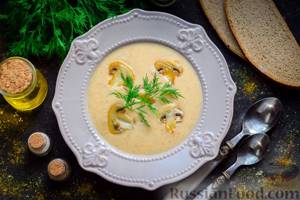
Products (for 3 servings)
- Cream cheese – 120 g
- Champignons – 300 g
- Cream 20% – 100 ml
- Potatoes – 3-4 pcs.
- Onions – 1 pc.
- Carrots – 1 pc.
- Salt - to taste
- Ground black pepper - to taste
- Dried ground garlic – 0.5 teaspoon
- Vegetable oil – 2 tbsp. spoons
- Fresh greens (for serving, optional) - to taste
- Water – 1.5 l
Recipe
- Cut the potatoes into medium pieces.
- Cut the carrots into arbitrary pieces or grate them on a coarse grater.
- Cut the onion into small pieces.
- Cut the champignons into medium pieces.
- Heat vegetable oil in a frying pan, add chopped vegetables and fry for 10 minutes, stirring occasionally.
- Place the vegetables in a saucepan, pour in 1.5 liters of warm water and cook over moderate heat for 25-30 minutes.
- Then add cream cheese to the pan.
- Pour in the cream, add salt, ground black pepper and dried garlic. Stir and cook the soup for another 7-8 minutes.
- Blend the soup using an immersion blender. Taste the soup, adjust the taste and serve.
- Pour cream cheese soup with mushrooms into bowls, garnish with fresh herbs if desired. You can serve the soup with croutons and separately fried mushrooms.
- Bon appetit!
Composition of nutrients, BJU
Cream soups
| For quantity: 100 grams | ||
| Calories — 52 | Calories from fat - 26 | |
| BJU | ||
| Total fat content | 2.84g | |
| Saturated | 1.11g | |
| Polyunsaturated | 0.76g | |
| Monounsaturated | 0.82g | |
| Cholesterol | 6mg | |
| Total carbohydrate content | 5.21g | |
| Dietary fiber | 0.21g | |
| Sugar | 1.6g | |
| Squirrels | 1.61g | |
| Vitamins and microelements | ||
| A - 22.33 µg | C - 0.43 mg | |
| B-6 – 0.02 mg | B-12 - 0.15mcg | |
| D - 0.23 µg | E - 0.19 mg | |
| Calcium 37mkg | Iron 0.23 mg | |
| Magnesium 4.69 mg | Zinc 0.27 mg | |
| Potassium 78 mg | Sodium 309 mg | |
Distribution of calories for BJU:Carbohydrates (39%) Fats (49%) Proteins (12%) | ||
